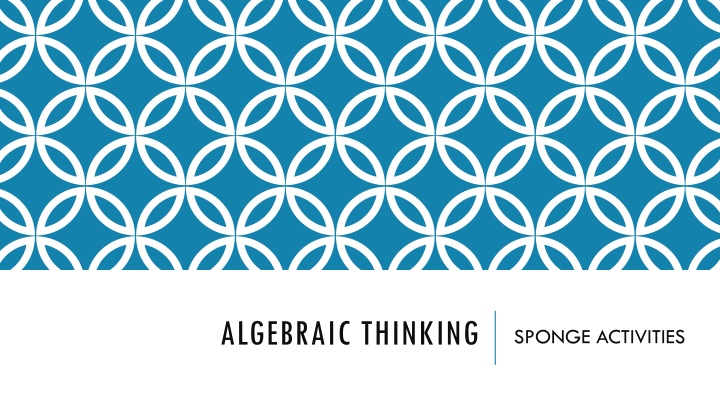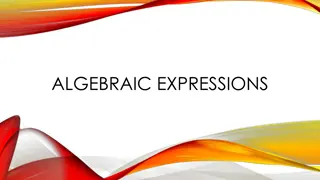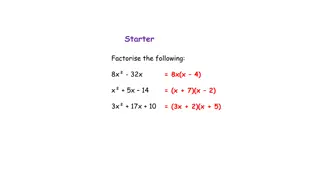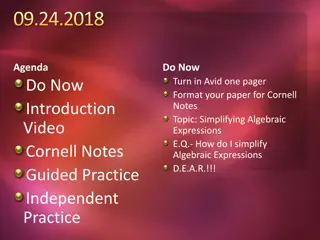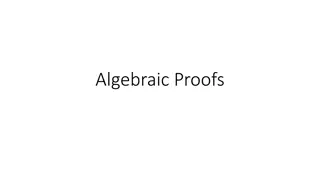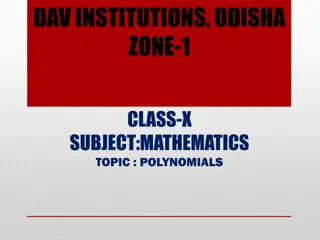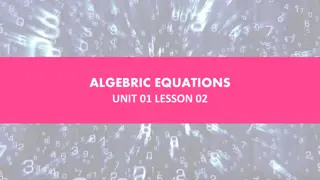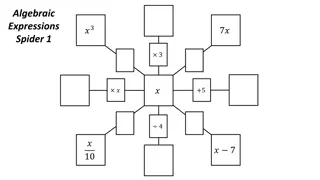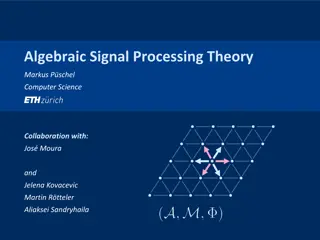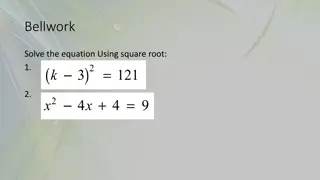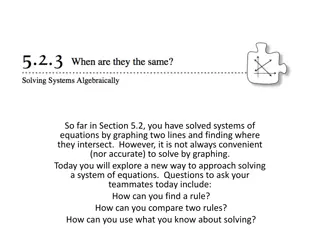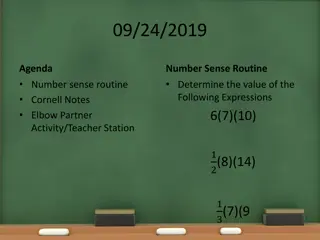Fun Algebraic Thinking Activities for Learning
Engage in a series of interactive algebraic thinking activities to enhance your problem-solving skills. From true or false equations to solving open sentences, these sponge activities will challenge and strengthen your mathematical reasoning abilities. Explore different identities and test your knowledge with various solving tasks. Also, practice completing tables and guessing rules to master the relationship between variables. Enjoy an educational journey inspired by M. L. Blanton's algebraic problem-solving approach.
Download Presentation

Please find below an Image/Link to download the presentation.
The content on the website is provided AS IS for your information and personal use only. It may not be sold, licensed, or shared on other websites without obtaining consent from the author.If you encounter any issues during the download, it is possible that the publisher has removed the file from their server.
You are allowed to download the files provided on this website for personal or commercial use, subject to the condition that they are used lawfully. All files are the property of their respective owners.
The content on the website is provided AS IS for your information and personal use only. It may not be sold, licensed, or shared on other websites without obtaining consent from the author.
E N D
Presentation Transcript
ALGEBRAIC THINKING SPONGE ACTIVITIES
TRUE OR FALSE. 8 + 4 = 5 + 7 5 = 4 + 1 6 0 = 6
IDENTITIES 5 + 0 = ____ 10 + 0 = ____ 8 + 0 = ____ + 0 =
IDENTITIES 5 0 = ____ 12 0 = ____ 7 0 = ____ 0 =
IDENTITIES 5 0 = ____ 11 0 = ____ 4 0 = ____ 0 = ____
IDENTITIES 6 1 = ____ 23 1 = ____ 3 1 = ____ 1 =
IDENTITIES 8 1 = ____ 17 1 = ____ 2.5 1 = ____ 1 =
SOLVE. + ___ = 1 5 + ___ = 13 ___ + ___ = 10 7 ___ = 42 ___ ___ = 16 ___ 4 = 3
SOLVE THE FOLLOWING OPEN SENTENCES. (2 ____ ) + 7 = 15 ____ 11 + 5 = 71 ____ 5 10 = 20
SOLVE. 11 + 6 + ____ = 27 2 4 + ____ = 16 (____ + 15 + 5) 6 = 150
In 0 1 2 3 Out 0 2 COMPLETE THE TABLE. GUESS THE RULE. If x is the input and y is the output, find a general equation for the relationship between x and y. 6 8 10 5 10 20 50 x Let x = the number of dogs and y = their number of eyes y = _____
COMPLETE THE TABLE. GUESS THE RULE. In 5 6 7 10 3 x Out 11 13 15 21 ____ y = _______
COMPLETE THE TABLE. GUESS THE RULE. In 0 1 2 3 4 x Out 5 10 20 40 _____ y = _______
ACKNOWLEDGEMENT The following problems were all adapted from Blanton, M. L. 2008. Algebra and the elementary classroom: Transforming thinking, transforming practice. Heinemann: Portsmouth, NH. Candy Problem p. 20 T-shirt Problem pp. 21-22 Triangle Puzzle Problem p. 25 Chickens Problem p. 26 Squares/Vertices Problem pp. 44, 181 Growing Caterpillar Problem pp. 53, 169 Handshakes Problem pp. 61, 175 Triangle Dots Problem pp. 64, 185 Paper Folding Problem pp. 76, 168
THE CANDY PROBLEM John and Mary each have a box of candies. Their boxes contain the same number of candies. Mary has 3 additional candies in her hand. How would you describe the amount of candy they each have? (adapted from Carraher, Schliemann, & Schwartz, 2008)
THE T-SHIRT PROBLEM I want to buy a t-shirt that costs $14. I have $8 saved already. How much more money do I need to earn to buy the shirt? What if the t-shirt costs $15? $16? $17? If $P stands for the price of any t-shirt I want to buy, write an expression using P that describes how much more money I need to buy the t-shirt.
THE TRIANGLE PUZZLE PROBLEM 12 7 4
THE MAGIC SQUARE PROBLEM Can you place the numbers 1, 2, 3, 4, 5, 6, 7, 8, and 9 in the figure below, so that when you are done, the sum of each row, column, and main diagonal is the same? This is called a magic square. If you think this is too easy, try a 4 x 4 magic square using the numbers 1 through 16.
THE CHICKEN PROBLEM Suppose Farmer Joe looks into his farm stall and counts 24 legs. He has 3 horses. If the remaining legs are on his prized chickens, how many chickens does he have?
THE SQUARES PROBLEM How many vertices are there in Figure 1? Figure 2? Figure 3? Figure 4? How many vertices would there be in a figure with n squares? Figure 1 Figure 2 Figure 3 Figure 4
THE GROWING CATERPILLAR PROBLEM Day 1 Day 2 Day 3 A caterpillar grows according to the chart above. If this continues, how long will the caterpillar be on Day 4? Day5? Day 10? Day 100? Day x? (Measure length by the number of circle body parts.)
THE HANDSHAKES PROBLEM How many handshakes will there be if 3 people shake hands, with each person shaking the hands of every other person once? How many handshakes will there be if 4 people shake hands? How many handshakes will there be if 5 people shake hands? How many handshakes will there be if 6 people shake hands? How many handshakes will there be if 50 people shake hands? How many handshakes will there be if n people shake hands?
THE TRIANGLE DOTS PROBLEM The figure below contains a drawing of a 5-dot triangle made by using 5 dots on each side of the triangle. The 5-dot triangle requires a total of 12 dots to construct. How many dots will be used to make a 3-dot triangle? A 4-dot triangle? A 10-dot triangle? A 100-dot triangle? An n-dot triangle?
THE PAPER FOLDING PROBLEM 1. Fold the paper in half. Open the paper and count the regions. 2. Refold the paper, then fold it in half again. How many regions do you have now? 3. Fold the paper in half a third time. Count the number of regions. 4. Make a table. f r 1 2 3 5. If you continued this process until you folded your original piece of paper 10 times, how many regions would this create? (Answer this without actually folding any paper.)
A BALANCED SCALE PROBLEM Source: Stiff, L. V. and Curcio, F. R. (Eds.). 1999. Developing mathematical reasoning in grades K-12. National Council of Teachers of Mathematics: Reston, VA. (p. 129)
FILL IN THE BLANK WITH <, >, OR =. Y Y 1. = = 6 6 _____ A E A E M M 2. = = 3 5 T _____ P T P
LOOKING FOR A PATTERN Find the remainder when 2625 is divided by 3.
